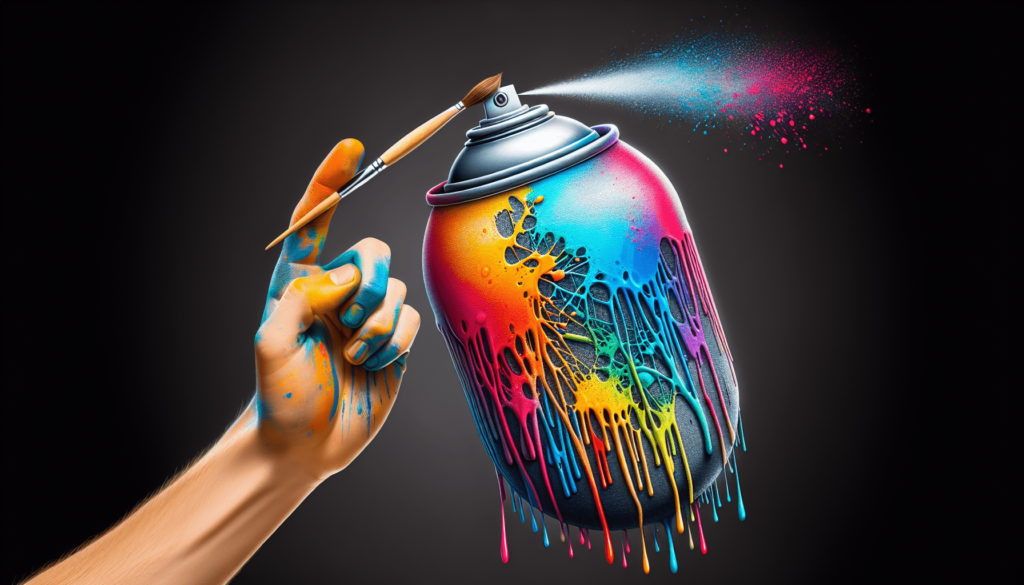In the realm of artistic expression, the question arises: Can you use spray paint with a brush? This seemingly unconventional method of application has intrigued many artists, prompting them to experiment with traditional tools in unconventional ways. While spray paint is traditionally used as a fast-drying aerosol that delivers a smooth, even finish, the idea of using a brush brings to mind a more controlled and textured approach. In this article, we will explore the possibilities, challenges, and potential benefits of using a brush with spray paint, uncovering the dynamic possibilities that arise when these two techniques intersect.

Understanding Spray Paint
What is spray paint?
Spray paint is a versatile and efficient method of applying paint to a variety of surfaces. It consists of a canister that contains pressurized paint, allowing it to be sprayed onto the desired surface in a fine mist. Spray paint is commonly used for wood, metal, plastic, and other materials, offering a quick and even coverage.
How does spray paint work?
Spray paint works by utilizing a combination of propellants and pigments. When the nozzle of the spray paint canister is pressed, the propellants inside release, creating pressure that forces the paint out in aerosol form. The pigments in the paint are dispersed within the propellant, allowing for even distribution onto the surface. The fine mist that is produced ensures a smooth and consistent finish.
Advantages of using spray paint
Using spray paint offers several advantages over traditional brush painting techniques. First and foremost, spray paint provides a quick and efficient coverage, allowing large areas to be painted in a fraction of the time it would take with a brush. The aerosol spray also ensures an even application, reducing the risk of brush strokes or uneven coverage. Additionally, spray paint can reach difficult-to-reach areas and provide a smooth finish, making it ideal for detailed projects or intricate designs.
Brushing Technique vs. Spray Technique
Differences between brushing and spraying
Brushing and spraying are two distinct techniques for applying paint, each with its own unique characteristics. Brushing involves using a paintbrush to manually spread the paint onto the surface, while spraying uses an aerosol canister to apply a fine mist of paint. Brushing typically results in visible brush marks and texture, while spraying produces a smoother and more uniform finish.
When to use brushing technique
The brushing technique is best suited for projects that require precision and control. It is commonly used for small areas or objects that have intricate designs or details. Brushing allows for better color blending and shading, making it a preferred method for artists or those looking to achieve a hand-painted aesthetic. It also provides better control over the thickness and texture of the paint.
When to use spray technique
The spray technique is best utilized for large surfaces or projects that require a smooth and even finish. It is particularly effective in covering large areas quickly and provides a seamless coat of paint. Spray painting is often chosen for outdoor surfaces, such as fences or furniture, as it allows for better coverage and durability. It is also ideal for objects with complex shapes or hard-to-reach areas.
Using Spray Paint with a Brush
The possibility of using spray paint with a brush
While spray paint is primarily intended to be used with a spray technique, it is possible to use it with a brush as well. This technique involves spraying the paint onto a palette or directly onto a disposable surface and then using a brush to pick up the paint and apply it to the desired surface. While it may not provide the same level of coverage or consistency as spray painting, it can be a viable option for certain projects.
Advantages and disadvantages
Using spray paint with a brush offers a few advantages. It allows for greater control and precision compared to spray painting, which is particularly useful when working on small areas or detailed designs. It also enables the use of a wider range of brushes, allowing for various brush strokes and effects. However, brush application may result in visible brush marks and texture, and it may require more layers of paint to achieve the desired coverage.
What types of projects are suitable for brush application with spray paint
Brush application with spray paint is most suitable for projects that require intricate detail work or for those who prefer a hand-painted look. It can be particularly useful for art projects, crafts, or small-scale touch-ups. Additionally, it can be handy when working with uneven surfaces or objects that are not easily accessible with a spray canister. Experimenting with spray paint and brush application can provide unique creative opportunities.
Preparing the Surface
Importance of surface preparation
Before applying spray paint, proper surface preparation is crucial for achieving a smooth and professional finish. Surface preparation helps to ensure proper paint adhesion, longevity, and overall quality of the final result. It involves cleaning the surface, removing any existing paint or coatings, and addressing any imperfections or damage.
Steps for preparing the surface
- Clean the surface: Remove any dirt, dust, grease, or other contaminants using a mild detergent or household cleaner. Rinse thoroughly and allow the surface to dry completely.
- Remove existing paint: If there is any loose or flaking paint, scrape it off using a scraper or sandpaper. For stubborn or old paint, a chemical paint stripper may be necessary. Follow the manufacturer’s instructions when using paint strippers.
- Smooth out imperfections: Fill in any cracks, dents, or holes in the surface using a suitable filler or putty. Allow it to dry and then sand the area gently to achieve a smooth finish.
- Sand the surface: Lightly sand the entire surface using fine-grit sandpaper to create a slightly rough texture. This promotes paint adhesion and helps the paint bond better with the surface.
- Clean again: After sanding, clean the surface once more to remove any dust or particles. A tack cloth can be effective in capturing any remaining debris.
Tips for achieving a smooth finish
To achieve a smooth finish when using spray paint with a brush, the following tips can be helpful:
- Use high-quality brushes: Invest in brushes specifically designed for use with spray paint. These brushes often have synthetic bristles that are better suited for working with aerosol paints, allowing for smoother application and reduced brush marks.
- Thin the paint if necessary: Depending on the project and desired effect, you may need to thin the spray paint before applying it with a brush. Follow the manufacturer’s instructions or experiment with small amounts of paint until you achieve the desired consistency.
- Work in thin layers: Apply thin, even coats of paint rather than a thick application. This helps prevent brush marks and allows for better control over the coverage.
- Sand between coats: Lightly sand the surface between coats of paint to promote adhesion and create a smoother finish. This helps to eliminate imperfections and ensure a professional result.
- Practice and experimentation: Before working on your final project, practice on a test surface to familiarize yourself with the process and refine your technique. Experiment with different brushes, paint consistencies, and application techniques to find what works best for your specific project.

Techniques for Brush Application
Choosing the right brush
When using spray paint with a brush, it is important to choose the right brush for the job. Synthetic brushes with soft bristles are generally recommended, as they allow for smoother application and better control over the paint. Look for brushes specifically designed for use with aerosol paints or consider synthetic brushes meant for watercolor or acrylic painting.
Applying spray paint with a brush
To apply spray paint with a brush, follow these steps:
- Shake the spray paint canister thoroughly to ensure the paint is properly mixed.
- Spray a small amount of paint onto a palette or a disposable surface.
- Dip the brush into the paint, allowing it to absorb a moderate amount.
- Apply the paint to the desired surface, using smooth and even strokes. Work in thin layers, allowing each layer to dry before applying the next.
- If necessary, repeat the process with additional layers until the desired coverage is achieved.
Blending and feathering techniques
When using a brush to apply spray paint, it is possible to achieve blending and feathering effects. Blending involves gradually mixing colors together to create smooth transitions, while feathering refers to softening the edges between different colors or shades. These techniques can be achieved with a brush by carefully applying and overlapping different colors, blending them together with gentle strokes or by using a dry brush technique.
Troubleshooting Common Issues
Common problems when using spray paint with a brush
While using spray paint with a brush can yield excellent results, there are common issues that may arise:
- Visible brush marks: Brush marks can occur if the paint is not applied evenly or if the brush strokes are too visible. This can be particularly challenging when working with darker colors or when using brushes that are not suitable for aerosol paint.
- Uneven coverage: Inconsistent coverage may occur if the paint is applied too thinly or if the brush strokes are not evenly spread. This issue can be more noticeable when transitioning between different areas or colors.
- Dripping or pooling: Excessive paint can drip or pool on the surface, leading to unwanted texture or a runny finish. This can happen if too much paint is picked up by the brush or if the brush is overloaded and not properly controlled.
- Paint buildup: Applying too many layers of paint without proper drying time can result in paint buildup, leading to a rough or uneven surface.
Solutions for brush application issues
To address common issues when using spray paint with a brush, consider the following solutions:
- Practice and refine technique: Take the time to practice on test surfaces, experimenting with different brushes, paint consistencies, and application techniques. This will help you identify and refine your technique, minimizing brush marks and achieving a smoother finish.
- Thin the paint if needed: If the paint is too thick, it can be difficult to achieve an even application. Consider thinning the paint slightly with an appropriate thinner or use a paint designed for brush application.
- Use appropriate brushes: Ensure you are using brushes specifically designed for aerosol paint application. These brushes are typically made with synthetic bristles that are better suited for working with spray paint, resulting in smoother application and reduced brush marks.
- Apply multiple thin layers: Instead of applying one thick layer, opt for multiple thin layers, allowing each one to dry before applying the next. This ensures better coverage and reduces the risk of buildup and texture issues.
Tips for avoiding and fixing brush marks
To avoid brush marks when using spray paint with a brush, consider the following tips:
- Work in a well-ventilated area to allow the paint to dry properly and reduce the risk of fumes or dust settling on the surface.
- Avoid overloading the brush with paint. Remove excess paint before applying it to the surface to help prevent drips or pooling.
- Use smooth and even strokes when applying the paint, aiming for uniform coverage.
- Sand between layers to smooth out any brush marks or texture. Lightly sand the surface with fine-grit sandpaper to achieve a smoother finish.
Best Practices for Using Spray Paint with a Brush
Practice on a test surface
Before tackling your final project, it is highly recommended to practice using spray paint with a brush on a test surface. This allows you to familiarize yourself with the technique and explore different brushes, paint consistencies, and application methods. By practicing on a test surface, you can refine your skills and gain confidence before moving on to your intended project.
Use appropriate brushes and techniques
Using the right brushes specifically designed for aerosol paint application is crucial when using spray paint with a brush. Synthetic brushes with soft bristles are generally recommended, as they allow for smoother application and better control over the paint. Additionally, experimenting with different paint consistencies, such as thinning the paint if necessary, can help achieve the desired effect and minimize brush marks.
Maintain a consistent brush stroke
Consistency in brush strokes is essential when using spray paint with a brush. Aim to apply the paint with smooth and even strokes, working in a methodical manner to ensure uniform coverage. This helps to minimize brush marks and create a professional finish. Practicing repetitive brush strokes on a test surface can help improve your technique and achieve consistency.
Finishing and Sealing
Choosing the right sealer
Once the spray paint has been applied with a brush and has fully dried, applying a sealer is recommended to protect the painted surface and enhance its durability. The choice of sealer depends on the project and desired finish. Acrylic sealers are a popular choice for a wide range of surfaces and offer protection against moisture, UV rays, and general wear and tear. However, it is important to read the manufacturer’s instructions and choose a sealer suitable for the specific type of paint and surface.
Tips for achieving a professional finish
To achieve a professional finish when using spray paint with a brush, consider the following tips:
- Ensure the painted surface is clean and free from dust or debris before applying the sealer.
- Use even and smooth brush strokes when applying the sealer, ensuring uniform coverage.
- Allow the sealer to dry completely between coats, following the manufacturer’s recommended drying time.
- Apply multiple thin layers of sealer rather than one thick coat to avoid drips or uneven appearance.
Curing and drying time
After applying the sealer, it is important to allow sufficient time for the paint and sealer to cure and dry. The curing and drying time can vary depending on factors such as temperature, humidity, and the specific products used. It is recommended to refer to the manufacturer’s instructions for the recommended drying time. Providing ample curing and drying time ensures that the paint and sealer have properly bonded, resulting in a durable and long-lasting finish.
Recommended Materials
Brushes suitable for spray paint application
When using spray paint with a brush, it is recommended to use brushes specifically designed for aerosol paint application. Synthetic brushes with soft bristles tend to work best, as they provide good control and reduce the risk of visible brush marks. Look for brushes labeled for use with aerosol paints or consider synthetic brushes meant for watercolor or acrylic painting.
Recommended spray paint brands
When choosing spray paint for brush application, consider reputable brands that offer a wide range of colors and finishes. Some popular spray paint brands known for their quality and performance include Rust-Oleum, Krylon, Montana, and Plasti Dip. It is advisable to read reviews and consider the specific needs of your project when selecting a spray paint brand.
Additional tools and materials
In addition to brushes and spray paint, there are other tools and materials that may be useful when using spray paint with a brush. These may include:
- Palette or disposable surface: For spraying the paint onto and picking it up with a brush.
- Sandpaper: For surface preparation and achieving a smooth finish.
- Filler or putty: To address imperfections or damage on the surface.
- Paint stripper: If necessary for removing old or stubborn paint.
- Tack cloth: For cleaning the surface and removing dust or particles before painting.
- Sealer: To protect the painted surface and enhance durability.
- Ventilation or respiratory protection: Depending on the project and location, ensuring proper ventilation or using respiratory protection may be necessary.
Conclusion
In conclusion, while spray paint is primarily intended for use with a spray technique, it is possible to use it with a brush as well. Understanding the differences between brushing and spraying techniques and knowing when to use each method can help you achieve the desired results for your project. Brush application with spray paint offers advantages such as greater control and the ability to achieve intricate details. Proper surface preparation, choosing the right brushes and techniques, and addressing common issues can help you achieve a smooth and professional finish. Utilizing recommended materials and following best practices for finishing and sealing will further enhance the durability and overall quality of your project. Experimenting with spray paint and brush application allows for versatility and creativity, offering unique opportunities to achieve stunning results.



